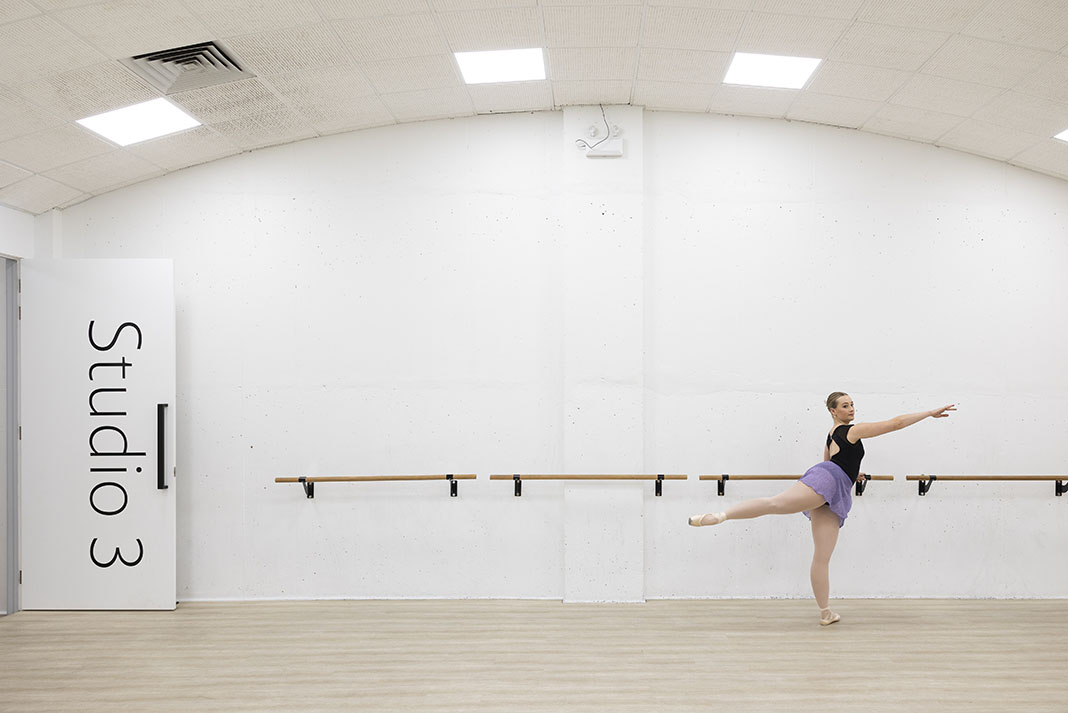Story
Raising the barre
words Heidi HELBIG
PHOTOGRAPHY pete thornton

As the curtain rises, Alice Cook graces the stage with the confidence, poise and composure of a professional ballet dancer.
Performing the principal role of Ariel the Little Mermaid in Barossa Dance Company’s 2023 ballet concert, it’s impossible to believe Alice was told only three years ago she would never dance again.
Despite being diagnosed with scoliosis, or curvature of the spine, Alice has never lost sight of her childhood dream.
“I remember watching the older girls and wishing one day I’d be the lead in ballet,” says the Tanunda teenager.
“This will be my 14th year – I can’t count how many dances I’ve been in. I’ve always loved it.
“Not many people find something like that – I’m very lucky.”
At the tender age of 19, Alice is already mentoring younger students as a teacher-in-training.
“It’s such a good feeling to have the little kids look up to you,” says Alice.
“It makes it worth it and you just want to do a good job – and they’re so cute!”
Despite her natural talent for dance, Alice’s regime is not for the faint-hearted. In addition to teaching, she does countless hours of rigorous practice in pointe, jazz and contemporary, as well as barre class and rehearsals for CanDance Australia fundraising concert at the Adelaide Entertainment Centre in aid of cancer research.


For Alice, it’s music that unlocks the power of dance.
“I love music. If I was told to do it without the music on, I would struggle, but as soon as the music comes on, it’s like a switch flicks in my brain and it just comes so naturally,” says Alice.
“I can’t run for two minutes, but I can dance for three hours.
“It’s only when you take your shoes off that it hurts – when you’re dancing, you’re too busy to focus on sore feet!”
Alice is particularly sentimental about her dance costumes.
“I love getting dressed up. I still have all of my costumes, I haven’t given a single one away – it takes up all of my parents’ wardrobe,” laughs Alice. “There’s too many memories to give away!”
She describes Barossa Dance Company like her “second family”, where dedication is rewarded with a supportive network of teachers and friends.
“All of us leads, we’re the best of friends,” says Alice. “Maddie Eggleton, who played Ursula (in The Little Mermaid), I’ve been friends with her since I was five. There’s no competition, everyone is so happy for each other.
“And the teachers, Miss Sarah (Hudson), Miss Katelyn (Menzel) and Miss Amy (Dobbs), they are just such great role models.”
Daily dance practice involves learning complex choreography, requiring students to transition between techniques and dance styles in quick succession.
“It keeps us on our toes,” says Alice. “One moment it’s strong and powerful, the next it’s lovely and soft and elegant.
“Sometimes when you do different combinations they will be strung together in different ways and you have to learn how to put it all together.”
Repetition helps, building strength and muscle memory.
“You learn 15 dances for your ballet exam and that helps you remember everything else,” says Alice.
“Mum said it must have helped my memory at school in tests and exams – I’ve always had quite a good memory from dance.”
And when the lights go down, a year of dedication and preparation comes to the fore.
“The only time I feel nervous is when the curtain is about to come up – but when the music comes on, I couldn’t care less,” says Alice.
“When I’m on stage I don’t really think about the audience, I just do my own thing.”




“When I’m on stage I don’t really think about the audience, I just do my own thing.”
- Alice Cook
Alice is especially grateful for the support of her family, who are her number one fans at concert time.
“Every concert – they’ve never missed one. Mum cries every year,” smiles Alice.
It’s these memories that sustained Alice after being diagnosed at the age of 15 with scoliosis curve, a rotation of the vertebrae which makes her spine appear like an ‘S’.
“I’ve had two back surgeries – it was not a good time,” says Alice.
“It wasn’t confronting at the start, because I’d gone through the majority of my life and hadn’t noticed it.
“Then I went to a back specialist and they confirmed more things were wrong and I was told to stop dancing – that was confronting.”
Alice’s vertebrae were pinned together with rods, screws and a metal cage in place of a disc, and she also received donor bone.
It’s a reminder of how easily her dreams could have slipped away.
“We went to another back specialist and he said I don’t want you to stop dancing because it’s keeping your back muscles strong. I was so happy,” Alice says.
“I’ve still got my two curves, 39 degrees and 49 degrees, and they have pinned my two vertebrae back together.
“It was quite a journey, but I’m still dancing.”
Her experience has also influenced her career aspirations, leading to occupational therapy study at university.
“I like working with kids, so hopefully I can do something with them and make a difference.”




